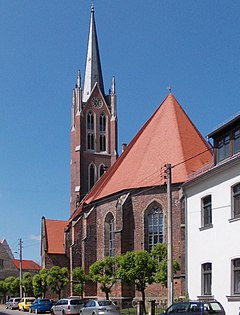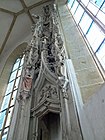St. Marien (Kemberg)
The St. Marien Church Kemberg is the Protestant town church of Kemberg near the Lutherstadt Wittenberg in the district of Wittenberg in Saxony-Anhalt . Your community is part of the parish of Wittenberg in Propst Sprengel Halle-Wittenberg of the Evangelical Church in Central Germany . The house of God is also known as the Church of Our Lady . It is a listed building. St. Marien is one of the reliably open churches .
history
A first church building in Kemberg with the name St. Wolfgang is assumed around the year 1200, but in a different place than the one today. St. Marien was built between 1290 and 1340. A larger church building had become necessary because of the increase in population and the relocation of the provost's office from Pratau to Kemberg between 1320 and 1330 because of frequent floods there. 1346 is named as the year of the consecration. The most prominent in the row of provosts of Kemberg was Nikolaus von Riesenburg around 1375 , who later became Bishop of Konstanz and Bishop of Olomouc . The sacristy and the south porch were built under Provost Löser in 1415 .
The Kemberg Church played an important role in the Reformation. According to tradition, Martin Luther , who was in Kemberg 14 times, preached in church just as often. The then provost Ziegelheim († 1518) is said to have been involved in the drafting of Luther's 95 theses . His successor and friend of Luther was Bartholomäus Bernhardi . He was the first pastor and provost to proclaim Protestant doctrine in Kemberg. In 1521 he was also the first Protestant pastor to marry despite his priestly vows. Thus Kemberg is considered to be the origin of the Protestant parish family. Bernhardi also caused that the corpse of Luther on the way from Eisleben to Wittenberg in the night from 21 to 22 February 1546 the Kemberger Church laid was.
Under Bernhardi's successor and son-in-law Matthias Wanckel , Lucas Cranach the Younger was commissioned in 1564 to create a new altar. In the same year the church received an organ, others followed in 1596 and 1807 and the current one in 1930/31. In the second half of the 16th century, the church was adapted to the Reformation requirements of worship, for example by moving the pulpit into the central nave and adding galleries.
The church tower had already been renovated in 1594 and 1656 when another repair was due around 1720. This was not completed until 1738 and the tower was given a baroque dome. In 1854 it was dilapidated again and parts of it had already collapsed. It was demolished and a higher neo-Gothic building was built according to plans by Friedrich August Ritter (1795–1869) from 1856 to 1859 . Since the city financed the construction, it is municipal property. It is sometimes referred to as the city tower and is also used by the city as an exhibition space.
From 1991 to 1993 major renovations were carried out, particularly on the tower.
In 1994 a smoldering fire partially destroyed the Cranach Altar. It was replaced by a modern altar in 2002.
description
architecture
St. Marien is a three-aisled Gothic hall church in brick, about 45 meters long and 22 meters wide. There are tall Gothic pointed arch windows between the outer buttresses . The gable roof is tiled.
The church is accessed via an annex on the south side and a door opposite on the north side. The sacristy with its own gable roof adjoins the north side.
The church has five bays and an apse with a 5/8 end . The organ gallery occupies the rear yoke. The long sides have further galleries. The ceiling is covered by a star vault .
The 86 meter high tower is characteristic of the cityscape. It stands slightly away from the nave and is connected to this via a connecting structure about half the height of the church. The distance became necessary because for its foundation 137 seven-meter-long oak stakes were driven into the ground and the nave was not to be damaged in the process. Four floors are indicated by pointed arch windows on the tower. At the corners there are diagonal buttresses that taper towards the top and end in small sandstone towers. The gables in between have clock faces from the church clock.
Furnishing
St. Marien owns pieces of equipment that go back to the 15th century, such as the sacrament house carved in sandstone , which was donated by Elector Friedrich the Wise .
The new altar, which became necessary due to the loss of the Cranach Altar, was created by the Austrian painter Arnulf Rainer and represents a wooden cross painted over with color. The German glass painter Günter Grohs created matching choir windows . The previous altar of the Cranach Altar, a wood-carved and heavily gilded Marian altar from around 1470 hangs in the choir room.
The pulpit, mainly made of stone from 1590, shows the pictures of the four evangelists and Jacob's dream of the ladder to heaven on the stairs . Proverbs and four scenes from the life of Jesus decorate the octagonal baptismal font from 1617, carried by an angel. On the gallery on the south side there are 35 pictures depicting scenes from Genesis . A triumphal cross from around 1500 is placed under the organ gallery.
The organ, built in 1933 by the Sauer company and restored in 2010, has 36 registers on three manuals . An electric-pneumatic pocket drawer serves as a fan .
There are three bells hanging in the tower. The middle one (diameter 1.06 m / height 0.90 m) is assumed to have been built around 1300, the other two (1.58 / 1.40 and 0.63 / 0.59) are labeled 1496. Further there there are two permanently installed clock bells (quarter and full hour) that are made to sound by a stop.
The Cranach Altar
From 1565 to the smoldering fire of 8./9. November 1994, when most of the altar was destroyed, the winged altar created by Lukas Cranach the Younger was the artistic highlight of the church. By opening and closing the middle wing, seven pictures could be shown. With the middle wings closed, four images of the Old Testament could be seen, namely Adam and Eve , the Flood , Sodom and Gomorrah and the bronze serpent, and with the wings closed, the New Testament baptism , crucifixion and resurrection of Jesus Christ . The two first Protestant preachers Bernhardi and Wanckel from Kemberg, the four "great ones from Wittenberg" (Luther, Melanchthon , Bugenhagen and Jonas ) and the painter himself are immortalized among those present in the baptismal picture . The Lord's Supper was depicted in the predella . The conversation narrowness of the altar contained, besides the presentation of the colliding into heaven Jesus arms and three little angels.
The two preserved and restored left panels with Adam and Eve as well as the Flood with the baptism on the back (with the historical personalities), a small model of the altar and remains of the destroyed panels can be seen in the sacristy of the church.
Although a "copy" of the altar was not possible after the fire and was rejected by the church in any form, some Kemberger citizens ordered a "reconstruction" of the picture panels from the Romanian painter Mariana Lepadus (* 1961) in Eisleben. This was completed in April 2017 and titled "Homage to Cranach" by the artist. The parish in Kemberg, however, stands by its resolution not to set up this work in the church. New Year 2018 it was given to the city of Kemberg. It should find its place in the still to be renovated cemetery chapel.
literature
- Dehio -Handbuch der Deutschen Kunstdenkmäler Sachsen-Anhalt Volume II: Administrative districts Dessau and Halle , Deutscher Kunstverlag 1999, ISBN 3-422-03065-4 , pp. 351–354
Web links
- Kemberg - Parish Church of St. Mary. In: Well-known and unknown Luther places in Saxony-Anhalt. Retrieved June 24, 2018 .
- History of the St. Marien town church. Retrieved June 24, 2018 .
- Kemberger town church “St. Marien “- Where old and new come together. In: Mitteldeutsche Zeitung online, August 26, 2015. Accessed June 24, 2018 .
- City of Kemberg. In: Staedtedaten.de. Retrieved June 24, 2018 .
- St. Mary's Church. In: World Heritage Region Anhalt • Dessau • Wittenberg. Retrieved June 24, 2018 .
Individual evidence
- ^ List of cultural monuments in Kemberg
- ↑ Opening times: Monday to Friday 10 a.m. to 12 p.m. and 1 p.m. to 4 p.m., public holidays and weekends 2 p.m. to 5 p.m.
- ↑ a b City of Kemberg. Retrieved June 24, 2018 .
- ↑ Information sheet from the Kemberg parish
- ^ History of the St. Marien town church. Retrieved June 24, 2018 .
- ^ Gallery in the city tower in Kemberg. In: Mitteldeutsche Zeitung online, July 25, 2016. Accessed June 25, 2018 .
- ↑ a b History of the church tower. Retrieved June 24, 2018 .
- ↑ Kemberg - Ev. St. Mary's Church. In: Deutscher Orgelbau.de. Retrieved June 24, 2018 .
- ^ Church in Kemberg Reconstruction of the Cranach altarpiece completed. In: Mitteldeutsche Zeitung online, April 21, 2017. Accessed June 28, 2018 .
- ↑ Homage to Cranach. In: website of Mariana Lepadus. Retrieved June 28, 2018 .
- ↑ My church, your church. In: Glaube und Heimat online, June 11, 2017. Accessed June 28, 2018 .
- ↑ Kemberger Church - Altar has new owner. In: Mitteldeutsche Zeitung online, January 19, 2018. Accessed June 28, 2018 .
Coordinates: 51 ° 46 ′ 27.6 " N , 12 ° 38 ′ 14" E











